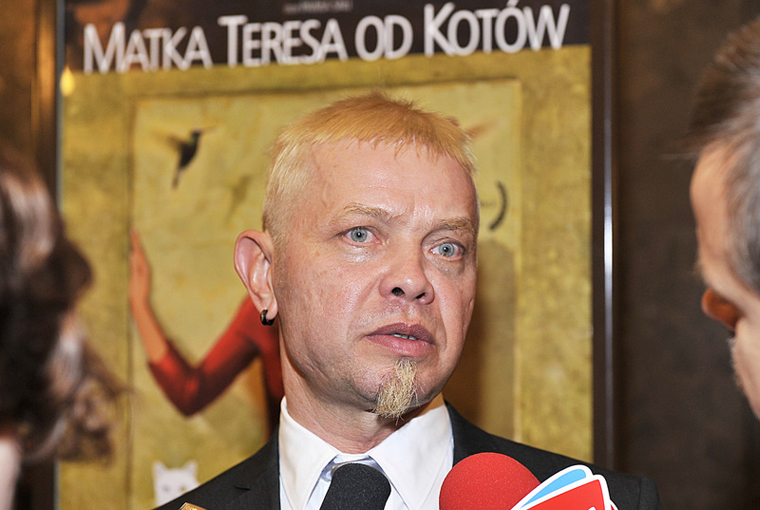
Mother Teresa of Cats” is Paweł Sala’s version of a matricide that happened in Poland during the nineties. We spoke to Sala about the style of the film, the psychology of the characters, and his upcoming projects.
You said you wanted to break away from the image of a classic detective film. Why did you choose this film to do this?
My film has nothing to do with classic detective films. I wanted to play with the public. We think that it is a crime story because the plot is based on a crime story, but it’s not the case. I didn’t want to make a film in a particular genre. The film is a little message for the public. Life isn’t what we think it is. For example right at the beginning of the film the audience know straight away who is the murderer and who is the victim. So, when we watch the film we don’t wonder about this. We aren’t trying to find this out. Therefore, we are ready to ask more complicated questions about society. At the end when we see this arrest scene, it’s mixed with the one at the beginning when we see the film, and it’s no longer clear that the victim is the victim and the that the murderers are criminals. So what we were sure of at the beginning, we are not sure of at the end.
I make films which are anti-genre but I don’t reject genre films. The story is the most important thing. The important thing was to make the film.
It’s a violent story, do you see this violence as a metaphor for something larger in society?
For me, the most violent type of film is one that talks about psychological violence. We have seen so much physical horror of the body that it no longer shocks us. The most shocking stories are stories about psychological violence which happen between people who are supposed to love each other.
The film is based on a real incident which really happened in Warsaw. It’s very shocking because of the murder of the mother. This is especially shocking in Poland because of the mother. Poland is a very Catholic country, the woman is the mother of God. Poland has gone through horrible times and wars. It was always the man who went away to fight while the woman is the silent heroine. The mother is the victim of her sons, which makes it even more disgraceful.
The presentation of the woman as the mother of God was very conspicuous at the end of the 90’s when this crime actually took place. But the story I present doesn’t take place in the 90’s, I took the same story and adapted it to the year 2010. This is important because if the same crime takes place in 2010 we don’t have the same reaction. Poland has changed a lot, especially politically and economically. We could say that Poland is already the same as all Western countries.
This film shows a clash between two very important figures in Poland. The mother figure and the father figure. In Poland the father is always a soldier. A soldier who can devote his life to his family and his country. If you know a bit about the history of Poland, you would know that the Polish soldier would be willing to risk his life not only for his country, but for his liberty and the liberty of others. The father in this film is a soldier who has been in Afghanistan. But the father in this film isn’t the heroic soldier that we imagine. It’s a man who goes to war just to earn money—he doesn’t think about liberty. There is no hero anymore. It also shows how, nowadays there are soldiers who are nothing like those of forty or fifty years ago, but are just in it for the money.
The most important scene for me is the one where we see the father coming home from a mission. He is with his family: his wife and two sons. The sons ask their father “how many people did you kill dad?” For them, it’s obvious that he must have killed someone because he is coming home from a war. The father doesn’t answer. It’s only the child who has the right to ask such a direct question. When a soldier gets home from a war, he’s a great man, a hero. But a child sees beyond this. This is what’s so powerful in this scene.
Do you think that the father played a large part in the boys conversion into criminals?
Journalists have spoken about the ‘virus of war’. This type of crime shows the effects of war. Indeed, the fact that the father was a soldier might have influenced this crime. I never talk about the ‘virus of war’ in my film. I didn’t want the cliché of the soldier who returns home and becomes terribly unhappy. I wanted to talk about a soldier who comes home and acts normally. All the Polish soldiers who came back from Afghanistan said they were fine. The same thing didn’t happen in the United States, people weren’t so positive. In Poland, we don’t speak about psychological troubles. People who are high up in the army aren’t really touched by what has happened. Close to Warsaw there is a special hospital for victims of war, but hardly anyone goes there. It’s taboo. This point is also about Polish society because if you have a psychological problem and you go to see a psychiatrist you are stigmatized. You can have a problem with your faith, you can even be an alcoholic but psychological problems are not accepted.
Did any particular films on the same subject inspire you—Psycho, Heavenly Creatures?
I didn’t want to use narration or scenography techniques from other filmmakers. The film’s structure is quite open and therefore the film interpretation is open to those who see it. Journalists have mainly compared my film to three stories: Crime and Punishment by Dostoevsky; Apocalypse Now by Francis Coppola and Krzysztov Kieslowski’s A Short Film about Love.
You wrote a play called “The burning of mother”, and I saw many similarities between this play and the film.
It’s not the first time that I’ve talked about the problems between boys and their parents. I wrote another play on the subject about boys who are orphans (A partir d’aujourd’hui on sera meilleur). For me, it’s very important to know why they are so unhappy. Why is there so much aggression and strong negative emotion in these boys? In The Burning of Mother the story is a bit different because the mother is dead as of the beginning of the story. Her son feels like her death was his fault and he’s trying to understand why he didn’t do anything. All these stories are crime stories. In Mother Teresa of Cats, the boys stayed in the room with the corpse for three days before going to stay with a friend of their mother.
So they hid the mother’s body in the closet. Was this a kind of refusal of her death?
That’s taking it a bit far. I wanted to show that the boys had trouble dealing with the situation, it was too much for them. For example there is a scene when the boys are travelling with a knife that is covered in blood, they completely forgot to dispose of it. They had not planned anything. They stayed in the room to hide things that the police would suspect, during this time they cut off their mother’s head to hide it somewhere else. They really wanted to get rid of the body at the beginning but they couldn’t so they kept it at the house. What really shocked the Polish people when the real story came out was the fact that the boys had really cut up the body, they had wrapped the head up so as to dispose of it separately.
How did you come across this story, and decide to make a film out of it?
I met a woman who works in television who used to be the neighbour of this family. She told me that it seemed to be a totally normal family. I wanted to show this, but also that it was quite an isolated family and difficult to approach. From an outside point of view we see a very typical family, we would never imagine this kind of thing would happen. I used this story because I wanted to consider why this kind of thing would happen.
What reason would you give someone to go and see your film?
Today’s society is so busy, we all move so fast that everything we do is mechanical. When something happens and we aren’t at all ready for it, all the mechanisms which we have don’t work anymore and we start doing stupid things. If there is a situation which we need to think about
we are handicapped, we don’t know what to do. So I prefer that this type of tragic situation be shared through art so we can prepare for it. It’s better to stop and consider this. Art isn’t only design, it’s depth.
Are you working on any new films at the moment?
I’ve already written two screenplays as part of a Polish program, a type of Polish cinema scholarship. But since writing the first, I realise making it would be like taking a step back. For me, the story is too similar to my last film and it’s not what I want to do. The second screenplay was a finalist in the Polish edition of Hartley-Merrill screenplay competition. I would need collaborators to do this. The second story takes place on a Mediterranean cruise but it would require a lot of money and it’s been put aside for the moment. We would need to do this as a co-production. Now I have decided to adapt a very well-known Polish novel Heroina by Tomasza Piątka. Like Mother Teresa of Cats its a story which talks about unhappiness. This particular story is about the drug heroin. The novel caused a lot of controversy when it came out in Poland because Piątka wrote the book while under the influence of the drug and it gives what some consider as a positive idea of the drug. This is a film about madness and addiction. It’s not purely about heroin or drugs. I want to speak more widely about addiction. Heroin, sex, power, money and religion are all on the same level of addiction. Each of us has a little addiction.
Thank you.
Translation by Marzena Moskal




Leave a Comment